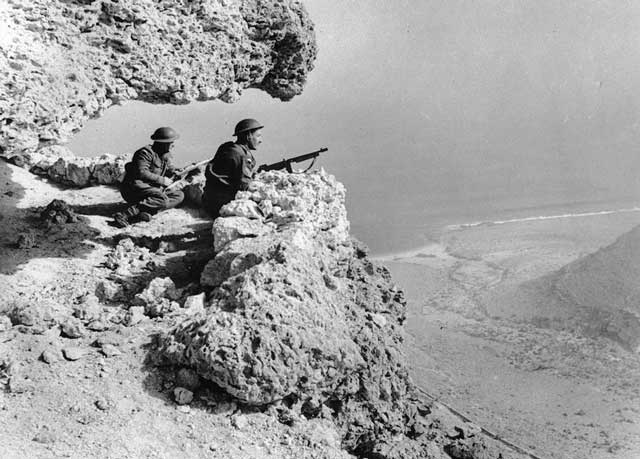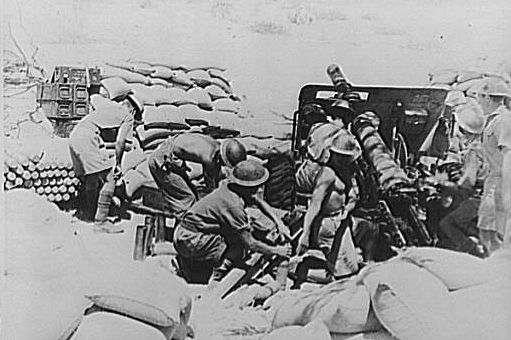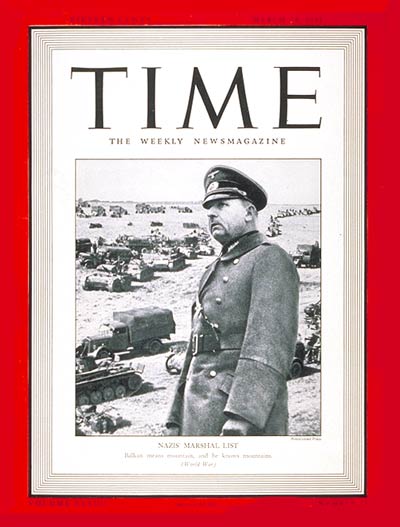Thursday 26 February 1942
 |
| Aerial reconnaissance photo of heavy cruiser Gneisenau in its Kiel drydock after having its bow blown off in an RAF raid. This is "Bomber" Harris' first major success as head of Bomber Command. |
 |
| "'Four members of Finucane's Squadron wheel out the new Spitfire. It has been specially prepared for his return'. Finucane is almost certainly Wing Commander Brendan 'Paddy' Finucane', an Irish-born RAF fighter ace of World War II." This picture was taken on 26 February 1942. © Daily Herald Archive / National Science & Media Museum / Science & Society Picture Library. |
 |
| Der Adler, 26 February 1942. |
US Navy submarine USS S-38 uses its deck gun to shell the radio station on Japanese-held Bawean Island in the Netherlands East Indies.
Japanese submarine HIJMS I-25, on its second patrol out of Kwajalein Atoll in the Marshall Islands, launches its Yokosuka E14Y1, Navy Type 0 "Glen" Small Reconnaissance Seaplane to fly over Melbourne, Australia's Port Phillip Bay. This is one in a series of such reconnaissance flights over Australia and New Zealand from mid-February to mid-March. The Allies do not spot any of these flights.
 |
| Three German soldiers in a foxhole who are manning an MG-34 machine gun in front of a knocked-out Soviet T-26 light tank, February 1942. |
 |
| An unidentified convoy sailing out of Brooklyn, New York, February 1942. USS Neville (AP-16) is in the foreground, with six or seven freighters and a light cruiser also visible. |
The night raids mark a turn of fortunes for the RAF. After several failed attempts to damage German heavy cruiser Gneisenau in its drydock in Kiel, RAF Bomber Command scores a major success. The RAF sends 49 aircraft (33 Wellingtons, 10 Hampdens, 6 Halifaxes) and loses 2 Wellingtons and one Halifax. A bomb hits the Gneisenau in the bow area, killing 116 crew and causing major damage. This one hit ends the career of Gneisenau, once a major threat in the North Atlantic. After this attack, the Gneisenau is towed to Gdynia but never is repaired. It is stripped of its guns and left as a lifeless hulk. While one bomber scores a hit, though, many of the bombers get lost and drop their bombs elsewhere. This includes the town of Kiel itself and locations as far as away as east Denmark. Thre are three deaths in Vejle, 100 miles north of Kiel, and 1 death in Odense.
RAF reconnaissance spots the German battleship they've been looking for, Tirpitz, at Trondheim. This ship is a major focus of the Royal Navy's strategy and its destruction is considered imperative. As Churchill likes to say, destroying the Tirpitz would alter the entire balance of world naval operations and allow major shifts to the Pacific.
 |
| Dutch tanker Mamura, sunk by U-504 on 26 February 1942 with no survivors. |
While moving through dense fog, 5030-ton US freighter Cassimir collides near the tip of the Frying Pan Shoals off North Carolina with another freighter, Lara. Cassimir sustains severe damage on its starboard side amidships and the crew abandons ship. Wartime conditions play a major role in such incidents, as ships are trying to maintain blackout conditions. The Lara, which sustains virtually no damage, takes aboard the survivors. There are 31 survivors and five deaths.
Brazilian 3557-ton collier Cabedello disappears on 26 February 1942 while en route from Philadelphia to Rio de Janeiro. The likeliest cause was a torpedo attack by an Italian submarine, but there is no record of this attack. Nobody survives.
 |
| British patrol on the lookout for enemy movements over a valley in the Western Desert, on the Egyptian side of the Egypt-Libya border, February 1942. |
British Prime Minister, under serious pressure in Parliament after recent reversals such as the successful German Channel Dash and the fall of Singapore, asks Middle East Commander General Claude Auchinleck to open an offensive against the Afrika Korps. Auchinleck, however, demurs, saying he needs to build his forces before he can attack from the Gazala Line. He says that he may have sufficient forces in place by June. British XIII Corps holds a 36-mile (58 km) line from Gazala to Bir Hacheim, while the British 30 Corps is further back along the Libya/Egyptian frontier.
 |
| Royal Navy Flower-class corvette HMS Campion in Londonderry, 26 February 1942. © IWM (A 7307). |
only by simultaneous offensive operations on two or more of the fronts can Hitler's armed forces be disposed of.The Western Allies, though, have no intention of opening a second front in 1942. In fact, the US Army is having serious doubts about following through with Operation Gymnast, the invasion of North Africa, before 1943.
Indian/Chinese Relations: Following the well-received (but at times embarrassing, due to meetings with independence leaders) visit by Chinese leader Chiang Kai-shek to India, the Indian (British) government appoints a "China Relations Officer." He is sir Edward Cook. New British Ambassador to China Sir Horace +
 |
| HM Motor Minesweeper J512 at Londonderry, 26 February 1942. © IWM (A 7306). |
American Homefront: The 14th Academy Awards are held in Los Angeles. Director John Ford and his "How Green Was My Valley" are the big winners, each earning Oscars. Documentary "Churchill's Island" wins the first Oscar in the new category "Best Documentary (Short Subject)." Gary Cooper wins the Best Actor Oscar for "Sergeant York," while Joan Fontaine wins for her performance in "Suspicion." Donald Crisp and Mary Astor win Best Supporting Oscars. "The Last Time I Saw Paris" from "Lady Be Good" wins for Best Original Song. "Citizen Kane," considered by many to be one of the best films of all time, wins only for "Best Original Screenplay," giving Orson Welles (along with Herman J. Mankiewicz) his only Oscar despite the film receiving nine nominations. This is due in large part to sustained hostility to Welles and his film from the Hearst newspaper chain.
 |
| Italian magazine Tempo, 26 February 1942. "Assault on an Enemy Position" is the cover story. |
February 1942
February 1, 1942: The US Navy Strikes Back
February 2, 1942: Germans Recovering in Russia
February 3, 1942: Japanese Shell and Bomb Singapore
February 4, 1942: Battle of Makassar Strait
February 5, 1942: Empress of Asia Sunk
February 6, 1942: The Christmas Island Body
February 7, 1942: The Double-V Campaign
February 8, 1942: Japan Invades Singapore
February 9, 1942: French Liner Normandie Capsizes
February 10, 1942: US Car Production Ends
February 11, 1942: Tomforce Fails on Singapore
February 12, 1942: The Channel Dash
February 13, 1942: Japanese Paratroopers In Action
February 14, 1942: RAF Orders Terror Raids
February 15, 1942: Japan Takes Singapore
February 17, 1942: Indian Troops Defect to Japanese
February 18, 1942: Battle of Badung Strait
February 19, 1942: FDR Authorizes Internment Camps
February 20, 1942: O'Hare the Hero
February 21, 1942: Crisis in Burma
February 22, 1942: Bomber Harris Takes Over
February 23, 1942: Bombardment of Ellwood, California
February 24, 1942: US Raid on Wake Island
February 25, 1942: Battle of Los Angeles
February 26, 1942: Gneisenau Eliminated
February 27, 1942: Battle of Java Sea
February 28, 1942: Battle of Sunda Strait
2020























